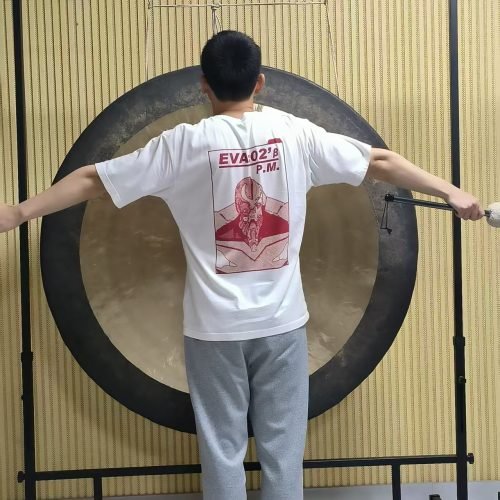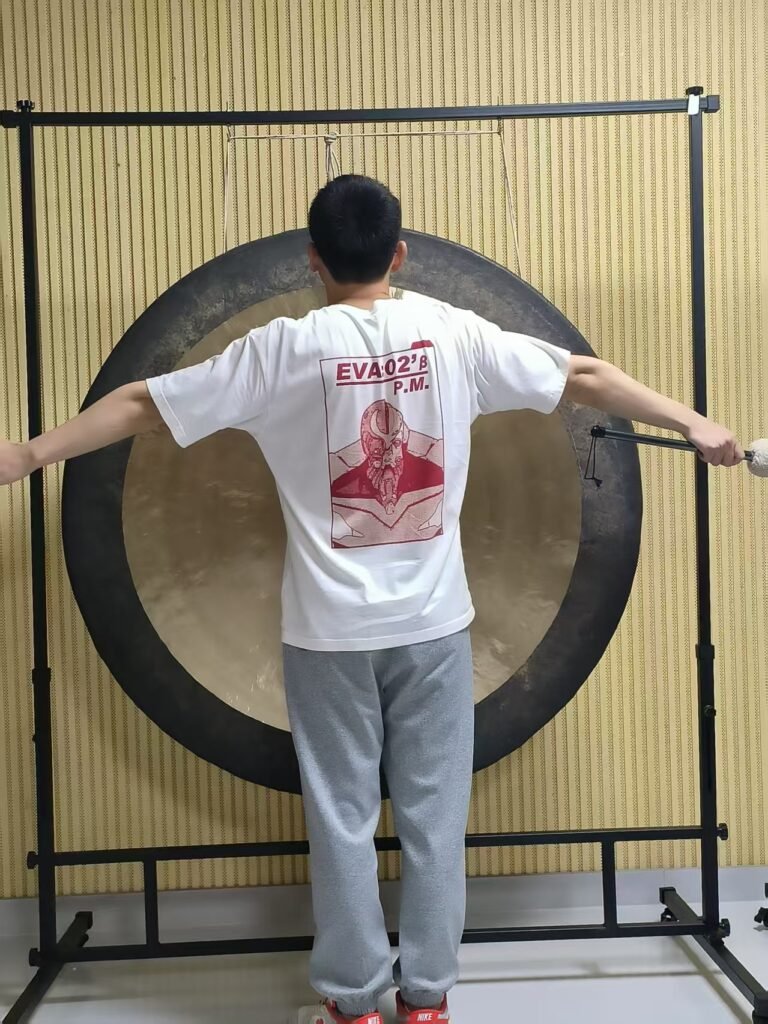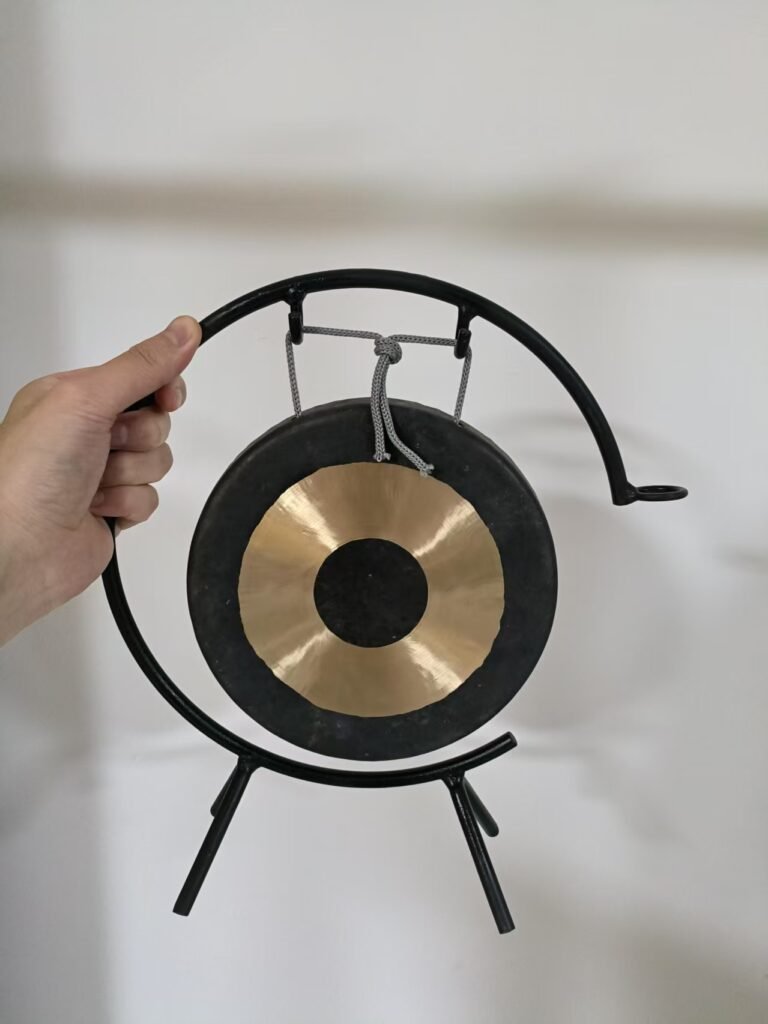

The ancient and resonant sound of the gong has captivated human consciousness for millennia, serving diverse purposes across cultures from ceremonial rituals to modern therapeutic applications. Today, as gongs find renewed relevance in professional music, sound therapy, meditation practice, and personal wellness, understanding the relationship between gong size and its optimal application has become crucial for practitioners, educators, and enthusiasts alike.
The size of a gong fundamentally determines its acoustic characteristics, creating distinct sound profiles that serve different purposes and environments. From the bright, penetrating tones of small gongs to the deep, enveloping resonance of large instruments, each size category offers unique sonic qualities that align with specific applications and user needs. This relationship between physical dimensions and acoustic properties forms the foundation for informed selection decisions that ensure optimal performance and satisfaction.
Modern applications of gongs span an extraordinary range of contexts, each with distinct requirements for sound characteristics, volume levels, portability, and environmental integration. Professional orchestras demand specific tonal qualities and dynamic ranges, while sound therapists require instruments that create healing acoustic environments. Educational institutions need gongs that serve pedagogical goals within practical constraints, and individual practitioners seek instruments that enhance personal spiritual development while fitting their living situations.
The complexity of gong selection extends beyond simple size considerations to encompass acoustic science, practical limitations, cultural traditions, and individual preferences that collectively determine the most appropriate instrument for any given application. Understanding these interconnected factors enables users to make informed decisions that maximize both functional effectiveness and personal satisfaction while respecting the cultural heritage and acoustic principles that define authentic gong practice.

The gong represents one of humanity’s most sophisticated acoustic instruments, utilizing the physics of vibrating metal to create complex sound environments that engage both auditory perception and physical sensation. Understanding the fundamental relationship between gong construction and acoustic output provides essential knowledge for appropriate size selection across different applications.
The basic structure of a gong consists of a circular metal disc, typically made from bronze alloys, that vibrates when struck to produce sound waves spanning a wide frequency spectrum. The diameter of this disc serves as the primary determinant of the instrument’s fundamental frequency, with larger diameters producing lower pitches according to established mathematical relationships governing vibrating circular membranes.
The relationship between diameter and acoustic characteristics follows physical laws where fundamental frequency decreases proportionally to the square of the diameter increase. This mathematical relationship means that doubling a gong’s diameter reduces its fundamental frequency by approximately two octaves, while also dramatically affecting overtone structure, dynamic range, and sustain characteristics that determine the instrument’s practical applications.
Thickness variations across the gong’s surface create complex vibrational patterns that generate the rich harmonic content characteristic of quality instruments. Traditional gong makers manipulate these thickness relationships to optimize specific acoustic qualities, with different regions of the gong contributing to various aspects of the overall sound including attack characteristics, sustain duration, and harmonic complexity.
Material composition significantly influences how size translates into acoustic characteristics, with traditional bronze alloys providing optimal relationships between diameter, mass, and vibrational properties. The specific metallurgical composition affects factors including frequency response, dynamic sensitivity, and tonal quality that interact with size parameters to determine overall acoustic performance.
Small Gongs (6-12 inches / 15-30cm)
Small gongs represent the most portable and accessible category of instruments, offering bright, penetrating sounds with quick attack and relatively short sustain characteristics. These instruments typically produce fundamental frequencies in the upper-mid to high range, with simple harmonic structures that provide clear tonal definition and excellent cut-through capability in ensemble situations.
The acoustic characteristics of small gongs include rapid response to playing dynamics, making them highly sensitive to technique variations while offering limited dynamic range compared to larger instruments. Their compact size enables easy integration into diverse musical and therapeutic contexts while providing sufficient volume for small to medium-sized spaces without overwhelming acoustic environments.
Medium Gongs (14-24 inches / 35-60cm)
Medium-sized gongs provide balanced acoustic characteristics that combine accessibility with substantial sonic capability, making them versatile choices for numerous applications. These instruments offer mid-range fundamental frequencies with developing harmonic complexity that creates warm, expressive tones suitable for both solo and ensemble applications.
The acoustic balance achieved by medium gongs includes responsive dynamic range that enables subtle expression while providing sufficient power for larger spaces and group applications. Their size represents an optimal compromise between portability and acoustic capability, making them popular choices for professional musicians, sound therapists, and serious practitioners seeking versatile instruments.
Large Gongs (26-40 inches / 65-100cm)
Large gongs produce the deep, resonant tones traditionally associated with the instrument’s most powerful and spiritually significant applications. These instruments generate low fundamental frequencies with complex harmonic structures that create immersive sound environments capable of filling large spaces and providing profound psychological impact.
The acoustic characteristics of large gongs include extended sustain duration, powerful dynamic range, and complex overtone development that evolves throughout the instrument’s decay cycle. Their substantial mass and size create acoustic phenomena including strong physical vibrations that engage listeners on multiple sensory levels while providing the acoustic foundation for deep meditative and therapeutic experiences.
Extra Large Gongs (42+ inches / 105cm+)

Check the large gong → https://dorhymigroup.com/product-category/gong/
Extra large gongs represent the ultimate expression of the instrument’s acoustic potential, producing extremely low fundamental frequencies with extraordinary sustain duration and complex harmonic development. These instruments create acoustic environments that transcend conventional musical applications to provide profound spiritual and therapeutic experiences through their overwhelming sonic presence.
The unique characteristics of extra large gongs include sub-audible frequency content that creates physical sensations, ultra-long decay times that maintain acoustic presence for minutes after striking, and harmonic complexity that continues evolving throughout extended sustain periods. Their massive size and acoustic output require specialized mounting, playing techniques, and acoustic environments that accommodate their extraordinary sonic capabilities.
The mathematical relationship between gong diameter and fundamental frequency follows established acoustic principles where frequency varies inversely with the square of the diameter. This relationship means that a gong twice the diameter of another produces a fundamental frequency approximately one-fourth as high, creating predictable frequency relationships that inform size selection for specific tonal requirements.
Harmonic structure complexity increases with gong size due to the greater surface area available for complex vibrational patterns and the longer decay times that allow harmonic development to emerge. Larger gongs support more complex overtone relationships while enabling subtle harmonic interactions that create the rich, evolving soundscapes characteristic of superior instruments.
Dynamic range expansion occurs with increased gong size as larger instruments provide greater surface area for energy storage and more complex vibrational patterns that respond to playing technique variations. This increased dynamic capability enables subtle expression at low volumes while providing tremendous acoustic power when required for large spaces or profound impact.
Sustain duration correlates directly with gong mass and size, as larger instruments store more vibrational energy while their greater mass maintains oscillation for extended periods. This extended sustain enables applications requiring long-duration acoustic environments while providing time for complex harmonic development that characterizes superior large gongs.

Small gongs demonstrate distinctive acoustic characteristics that make them suitable for specific applications requiring bright, defined sounds with quick response and excellent clarity. The frequency response of small gongs typically emphasizes upper-mid and high frequencies, creating penetrating tones that cut through complex acoustic environments while providing clear attack characteristics essential for rhythmic and percussive applications.
The tonal qualities of small gongs include brightness and clarity that facilitate melodic and rhythmic definition in ensemble contexts. Their simple harmonic structures provide clean, unambiguous pitches that integrate well with other instruments while offering sufficient character to maintain individual identity. The quick attack and relatively short sustain make them ideal for rhythmic applications requiring precise timing and clear articulation.
Dynamic characteristics of small gongs demonstrate high sensitivity to playing technique while offering limited overall dynamic range compared to larger instruments. Their responsive nature enables subtle expression through technique variations, though their smaller mass limits the maximum acoustic output achievable. The rapid decay characteristics require specific playing approaches to maintain sustained tones when desired.
Medium gongs provide balanced acoustic characteristics that combine many advantages of both small and large instruments while avoiding the limitations of either extreme. Their frequency response typically emphasizes mid-range content with developing low-frequency presence and sufficient high-frequency definition to maintain clarity and projection in diverse acoustic environments.
The tonal versatility of medium gongs enables them to serve multiple roles within single applications while providing sufficient character development to maintain interest throughout extended listening periods. Their harmonic complexity surpasses small gongs while remaining manageable and musical rather than overwhelming, creating warm, expressive sounds that appeal to broad audiences and serve diverse aesthetic preferences.
Dynamic flexibility represents perhaps the greatest advantage of medium gongs, as they provide substantial dynamic range while maintaining sensitivity to technique variations. This combination enables both subtle, intimate expression and powerful, room-filling presence as required by different musical and therapeutic contexts. Their balanced acoustic characteristics make them suitable for both solo and ensemble applications.
Large gongs produce the profound, resonant tones that define the instrument’s most powerful and spiritually significant applications. Their frequency response emphasizes low and sub-low frequencies while maintaining sufficient harmonic complexity to avoid muddiness or lack of definition. The fundamental frequencies produced by large gongs create acoustic foundations that support complex harmonic structures rather than competing with them.
The tonal depth and complexity of large gongs develop throughout extended decay cycles, with different harmonic components emerging and receding over time to create evolving soundscapes that maintain interest and provide ongoing discovery for listeners. This acoustic complexity supports meditative and therapeutic applications that benefit from long-duration, evolving sound environments.
The acoustic projection capabilities of large gongs enable them to fill substantial spaces while maintaining tonal integrity and harmonic definition. Their substantial mass and size create acoustic phenomena including room resonance activation and harmonic reinforcement that enhance their natural acoustic output while creating immersive listening experiences that engage listeners on multiple sensory levels.
Classical orchestral literature places specific demands on gong selection that reflect both historical performance practices and contemporary acoustic requirements within modern concert halls. Traditional repertoire typically calls for instruments in the 28-36 inch range that provide sufficient acoustic power to balance full orchestras while offering the tonal characteristics that composers associated with the gong’s dramatic and spiritual roles.
The acoustic requirements of symphonic performance include sufficient dynamic range to support everything from subtle atmospheric effects to overwhelming climactic moments that define many of the instrument’s most famous applications. Concert hall acoustics influence size selection, with larger venues typically requiring more substantial instruments to achieve appropriate acoustic balance, while smaller venues may benefit from more moderate sizes that avoid overwhelming the acoustic space.
Performance technique considerations in orchestral contexts emphasize controlled dynamic expression and precise timing that require instruments responsive to subtle technique variations while providing predictable acoustic behavior. Professional orchestral gongs must offer consistent performance characteristics across varying dynamic levels while maintaining tonal integrity under the demanding conditions of live performance with full orchestras.
Modern compositional practices have expanded gong applications far beyond traditional orchestral roles to include extended techniques, electronic integration, and innovative sonic exploration that places different demands on instrument selection. Contemporary composers often specify particular size ranges or multiple gongs to achieve specific acoustic effects that serve their artistic visions and technical requirements.
Electronic music integration requires gongs that record and process well while providing sufficient acoustic interest to justify their inclusion in electronically enhanced contexts. This application often favors instruments with complex harmonic content and extended sustain characteristics that provide raw material for electronic manipulation and processing techniques that expand the instrument’s sonic possibilities.
Experimental performance techniques including bowing, scraping, and preparation require instruments that respond well to non-traditional playing methods while maintaining structural integrity under unusual performance demands. These applications may favor specific size ranges that optimize the effectiveness of extended techniques while providing access to sonic territories unavailable through conventional playing methods.
Traditional applications of gongs in various cultural contexts provide historical precedents for size selection while informing contemporary adaptations that respect cultural authenticity while serving modern performance requirements. Asian musical traditions typically utilize specific size ranges that serve established aesthetic and practical requirements within traditional ensemble contexts and ceremonial applications.
Western adaptations of traditional gong applications often require modifications to accommodate different acoustic environments, ensemble compositions, and performance practices while maintaining connection to authentic traditional approaches. These adaptations may involve size adjustments that optimize performance within Western musical contexts while preserving essential cultural and aesthetic characteristics.
Cross-cultural fusion applications create opportunities for innovative size selection that serves multiple traditional approaches while enabling new artistic expressions that transcend individual cultural boundaries. These applications require understanding of various traditional approaches while maintaining flexibility for creative adaptation and artistic innovation.
Individual meditation practice represents one of the most common contemporary applications for gongs, with specific size requirements that reflect personal preferences, living situations, and meditative goals. Home environments typically favor smaller to medium-sized instruments (8-20 inches) that provide sufficient acoustic presence for personal practice while avoiding overwhelming small spaces or disturbing neighbors and family members.
Different meditation techniques benefit from specific acoustic characteristics that influence appropriate size selection. Concentration practices often benefit from smaller gongs that provide clear, defined tones for focal attention, while deeper contemplative practices may favor larger instruments that create immersive sound environments supporting expanded awareness and consciousness exploration.
Experience levels influence size preferences, with beginners often finding smaller, more manageable instruments easier to integrate into developing practices, while experienced practitioners may gravitate toward larger gongs that provide the acoustic depth and complexity that supports advanced contemplative states and sophisticated meditative techniques.
Sound therapy practitioners require instruments that serve diverse client needs while adapting to various treatment environments and therapeutic goals. The selection of appropriate gong sizes for professional practice involves balancing acoustic effectiveness with practical considerations including portability, storage, and client sensitivities that affect treatment outcomes and practice sustainability.
Different therapeutic applications benefit from specific acoustic characteristics that guide size selection decisions. Relaxation and stress reduction treatments often utilize medium to large gongs (20-30 inches) that provide enveloping sound environments without overwhelming sensitive clients, while deeper therapeutic work may require larger instruments that create profound acoustic experiences supporting significant consciousness shifts and healing processes.
Treatment environment factors significantly influence appropriate gong sizes for professional practice. Private practice rooms may require different instruments than larger workshop spaces, while outdoor and retreat settings create additional considerations for acoustic projection and environmental integration that affect optimal size selection for therapeutic effectiveness.
Group meditation sessions and sound healing workshops require gongs that provide sufficient acoustic power to serve multiple participants while creating shared experiences that enhance group cohesion and collective spiritual development. Large groups typically require larger instruments (28+ inches) that provide adequate acoustic coverage while creating the profound acoustic presence that defines transformative group sound experiences.
Workshop duration and intensity influence size requirements, with longer sessions potentially benefiting from instruments that maintain acoustic interest throughout extended periods while avoiding fatigue or overwhelm that can compromise participant experience and therapeutic effectiveness. The acoustic characteristics required for group leadership differ from those needed for individual practice, often requiring more substantial instruments that command attention and create shared focal points.
Venue acoustics play crucial roles in determining appropriate gong sizes for group applications, with indoor spaces requiring different acoustic approaches than outdoor settings, while venue size and acoustic treatment affect optimal instrument selection for maximum effectiveness and participant satisfaction.
Educational applications of gongs require instruments that serve pedagogical goals while accommodating institutional constraints including budget limitations, storage requirements, and multiple user needs. School music programs typically benefit from medium-sized instruments (16-22 inches) that provide educational value while remaining manageable for students of various ages and experience levels.
Age-appropriate sizing considers both physical capabilities and acoustic sensitivity, with younger students often requiring smaller instruments that match their physical development while providing engaging acoustic experiences that support learning and musical development. Progressive sizing through educational levels enables skill development while introducing students to the instrument’s full range of acoustic possibilities.
Curriculum integration requirements influence gong selection for educational contexts, with instruments needed to support various learning objectives including rhythm training, acoustic awareness, ensemble participation, and cultural education that requires authentic instruments representing traditional applications and cultural significance.
Professional training programs for sound therapy practitioners require comprehensive instrument collections that expose students to the full range of gong applications while providing hands-on experience with different sizes and their specific therapeutic applications. Training collections typically include multiple sizes that demonstrate the relationships between acoustic characteristics and therapeutic effectiveness.
Skill development progression benefits from graduated exposure to different gong sizes that enables students to understand how acoustic characteristics relate to therapeutic applications while developing the sensitivity and technique required for professional practice. Training programs must balance comprehensive exposure with practical considerations including program duration, budget constraints, and individual student needs.
Professional preparation requirements include familiarity with size selection criteria for different therapeutic applications, client populations, and treatment environments that enables graduates to make informed decisions about instrument acquisition and application throughout their professional careers.
Recording applications place specific demands on gong selection that reflect both acoustic requirements and technical constraints inherent in studio environments. Recording spaces typically have limited acoustic volume compared to live performance venues, which may favor smaller to medium-sized instruments that provide appropriate acoustic scale while enabling detailed capture of harmonic content and dynamic expression.
Microphone placement and recording techniques influence optimal gong sizes for studio applications, with larger instruments requiring more complex microphone arrangements and acoustic treatment to capture their full sonic spectrum while avoiding unwanted room interactions and acoustic complications that compromise recording quality.
Post-production considerations include how different gong sizes respond to various processing techniques, with some sizes providing better raw material for electronic manipulation while others work better in natural acoustic recordings that preserve the instrument’s authentic character and cultural significance.
Different musical genres place varying demands on gong selection that reflect aesthetic preferences, traditional practices, and technical requirements specific to each style. Classical music recording typically requires instruments that match historical performance practices while providing acoustic characteristics appropriate for the recording format and intended audience.
Popular music production often emphasizes specific acoustic characteristics that serve contemporary aesthetic preferences while providing sufficient impact and presence to compete effectively in dense mix environments typical of modern commercial recordings. These requirements may favor particular size ranges that optimize effectiveness within contemporary production contexts.
World music recordings require cultural authenticity that may dictate specific size ranges while accommodating modern recording techniques and distribution formats that serve contemporary audiences while preserving traditional aesthetic values and cultural significance.
Film and television scoring applications require gongs that provide specific emotional and atmospheric effects while integrating effectively with other musical and sound elements. These applications often emphasize particular acoustic characteristics that support dramatic requirements while fitting within established audio technical standards and mixing practices.
Game audio applications present unique requirements including loop compatibility, interactive responsiveness, and technical optimization that influence appropriate gong selection for digital audio environments. These applications may favor instruments with specific acoustic characteristics that translate effectively through various playback systems and technical processing requirements.
Multimedia art projects create opportunities for innovative gong applications that may require unusual size selections or combinations that serve artistic visions while accommodating technical constraints and creative objectives that transcend traditional musical or therapeutic applications.
Residential use of gongs requires careful consideration of living space characteristics, neighbor relationships, and family dynamics that significantly influence appropriate size selection. Apartment living typically necessitates smaller instruments (6-12 inches) that provide meaningful acoustic experiences while respecting sound transmission limitations and maintaining harmonious relationships with neighbors and family members.
Room acoustics in typical home environments differ significantly from dedicated musical or therapeutic spaces, often requiring size adjustments that optimize acoustic behavior within domestic settings. Hard surfaces, furniture arrangements, and room dimensions affect how different gong sizes perform, with some sizes working better in specific acoustic environments than others.
Storage and display considerations influence practical size limitations for home use, with larger instruments requiring dedicated stands, storage arrangements, and display spaces that may not be available in typical residential settings. These practical limitations often override acoustic preferences in determining maximum feasible sizes for home applications.
Individual meditation and spiritual practice goals significantly influence appropriate gong sizes for personal use, with different contemplative traditions and personal development objectives favoring specific acoustic characteristics. Deep meditation practices may benefit from larger instruments that create immersive sound environments, while daily mindfulness practices might work better with smaller, more subtle instruments.
Personal acoustic sensitivity varies significantly among individuals, with some practitioners preferring the gentle approach of smaller gongs while others require the profound impact of larger instruments to achieve desired contemplative states. Understanding personal preferences and sensitivities guides size selection that enhances rather than hinders individual practice development.
Skill development considerations include how different sizes support learning and practice advancement, with some practitioners benefiting from starting with smaller instruments before progressing to larger ones, while others find immediate connection with substantial instruments that provide rich acoustic complexity from the beginning of their practice journey.
Investment planning for personal gong acquisition involves balancing immediate needs with long-term practice development and potential collection expansion. Initial purchases should consider upgrade pathways while providing immediate satisfaction and practical utility that supports regular practice and continued interest in the instrument.
Cost-effectiveness evaluation includes comparing acoustic capability with financial investment to ensure optimal value for individual circumstances and practice requirements. Higher-quality smaller gongs may provide better long-term value than lower-quality larger instruments, depending on individual priorities and usage patterns.
Used market considerations may enable access to larger or higher-quality instruments within limited budgets while requiring additional knowledge about quality assessment and potential risks associated with used instrument purchases. Understanding market values and quality indicators helps optimize purchasing decisions within budget constraints.
Effective gong selection begins with honest assessment of intended applications, personal preferences, and practical constraints that will influence daily use and long-term satisfaction. Primary application identification helps establish acoustic requirements while secondary uses inform versatility needs that may influence size selection toward instruments capable of serving multiple purposes effectively.
Technical requirements assessment involves defining specific acoustic characteristics needed for intended applications, including frequency range preferences, dynamic requirements, and sustain characteristics that serve identified uses. Understanding these technical requirements enables focused evaluation of available options while avoiding inappropriate selections that fail to meet essential needs.
Practical constraints evaluation includes honest assessment of space limitations, budget restrictions, and lifestyle factors that affect feasible instrument sizes and usage patterns. These constraints often provide more definitive guidance than preferences, requiring realistic approaches to size selection that ensure practical viability and sustainable use.
Comprehensive budget planning includes not only instrument acquisition costs but also accessories, maintenance, and potential future expansion that affects overall investment requirements. Initial budget allocation should balance instrument quality with accessory needs including appropriate mallets, stands, and protective equipment necessary for proper use and care.
Long-term investment perspective considers how initial purchases fit within broader practice development and potential collection expansion, with some practitioners benefiting from higher initial investments in quality instruments that provide extended utility while others prefer conservative approaches that enable experimentation before major commitments.
Value optimization strategies include identifying the size and quality combination that provides maximum utility for available resources while maintaining flexibility for future development and changing needs that may emerge through practice experience and skill advancement.
Quality assessment criteria include evaluation of acoustic performance, construction quality, and aesthetic characteristics that determine long-term satisfaction and practical utility. Understanding quality indicators enables informed comparisons between available options while ensuring investments in instruments that provide lasting value and appropriate performance characteristics.
Brand and source evaluation involves researching manufacturer reputations, product reliability, and customer service quality that affect both initial satisfaction and long-term ownership experience. Established manufacturers typically provide more predictable quality and better support while newer producers may offer innovative features or competitive pricing that appeals to specific needs.
Testing and trial methods enable direct evaluation of acoustic characteristics and personal compatibility before purchase commitments. Whenever possible, hands-on testing provides invaluable information about instrument suitability while building understanding of personal preferences and requirements that guide optimal selection decisions.
Different gong sizes require varying approaches to maintenance and care that optimize longevity while preserving acoustic characteristics and aesthetic appearance. Small gongs typically require less specialized equipment and storage arrangements while remaining vulnerable to damage from improper handling or inadequate protection during storage and transportation.
Large gongs demand specialized support systems, cleaning approaches, and storage arrangements that accommodate their size and weight while protecting their surfaces and maintaining structural integrity. Professional mounting systems become essential for larger instruments, while specialized cleaning tools and techniques ensure proper maintenance without damage to delicate surface finishes.
Environmental protection requirements scale with gong size, as larger instruments present greater surface areas susceptible to environmental damage while requiring more substantial protective measures during storage and transportation. Climate control becomes increasingly important for larger, more valuable instruments that represent significant investments and irreplaceable acoustic resources.
Size-appropriate playing techniques optimize acoustic performance while protecting instruments from damage caused by inappropriate playing methods. Small gongs respond well to lighter mallets and more delicate technique approaches that bring out their natural brightness and clarity while avoiding overwhelming their limited dynamic capacity.
Medium gongs enable broader technique ranges including both subtle expression and more powerful playing approaches that take advantage of their balanced acoustic characteristics. Mallet selection becomes more critical with medium gongs, as different mallets produce significantly different acoustic results that affect both immediate sound production and long-term instrument care.
Large gongs require specialized playing approaches that accommodate their extended response times and complex acoustic behavior while utilizing appropriate mallets and technique that bring out their natural acoustic capabilities. Understanding large gong behavior enables effective playing while protecting these substantial investments from damage caused by inappropriate technique.
Usage frequency planning helps maintain instrument condition while optimizing practice effectiveness and personal development. Regular but moderate use typically provides optimal results while avoiding overuse that can cause listener fatigue or instrument wear that compromises acoustic performance and longevity.
Skill development pathways include progression through different playing techniques and potentially different instrument sizes that support advancing capabilities and evolving practice needs. Understanding development patterns helps plan instrument acquisition and usage that supports continued growth while maximizing investment value.
Community resource utilization provides access to larger instruments and specialized knowledge that may not be available for individual ownership while building connections with other practitioners that enhance learning and practice development opportunities.
The “bigger is better” misconception leads many practitioners toward inappropriate instrument selections that exceed their practical needs, usage capabilities, or environmental constraints. While large gongs provide impressive acoustic capabilities, they may not serve individual needs as effectively as appropriately sized smaller instruments that better match actual usage requirements and practical limitations.
Ignoring environmental factors represents another common error where practitioners select instruments based on acoustic preferences without considering living situations, neighbor relationships, or space limitations that ultimately determine practical usability. These environmental factors often provide more definitive guidance than acoustic preferences in determining optimal size selections.
Budget misalignment occurs when practitioners focus exclusively on size preferences without realistic assessment of total ownership costs including accessories, maintenance, and storage requirements that affect long-term satisfaction and practical viability. Comprehensive cost analysis enables more appropriate selection decisions that optimize value within realistic budget constraints.
Overuse problems can develop when practitioners rely too heavily on single instruments without developing broader technique ranges or understanding of appropriate usage patterns that maintain effectiveness while avoiding listener fatigue. Balanced practice approaches include variety in technique and potentially multiple instruments that serve different aspects of personal development.
Improper maintenance leads to acoustic degradation and potential damage that compromises instrument performance while reducing long-term value and satisfaction. Understanding appropriate care methods and implementing consistent maintenance practices preserves instrument condition while optimizing acoustic performance throughout extended ownership periods.
Technique inadequacy limits acoustic potential while potentially causing instrument damage through inappropriate playing methods. Continued learning and technique development maximize instrument capabilities while protecting investments through proper usage that serves both immediate needs and long-term practice development.
Evidence-based selection approaches utilize objective acoustic measurement, practical assessment, and systematic evaluation that reduce reliance on subjective impressions or marketing claims that may not reflect actual performance characteristics or suitability for specific applications. Scientific methods enable more reliable selection decisions that optimize outcomes while avoiding common pitfalls.
Professional consultation provides access to specialized knowledge and experience that informs selection decisions while reducing risks associated with inexperience or inadequate information. Expert guidance can significantly improve selection outcomes while providing educational value that supports continued learning and development.
Continuous learning and adaptation enable practitioners to refine their understanding of instrument requirements while developing skills that maximize acoustic potential and personal satisfaction. Ongoing education supports better selection decisions while enhancing usage effectiveness and long-term practice development.
The fundamental principle of purpose-driven selection ensures that gong size choices align with actual usage requirements rather than abstract preferences or misconceptions about instrument capabilities. Understanding specific acoustic needs, environmental constraints, and practical limitations provides reliable guidance for appropriate size selection that optimizes both immediate satisfaction and long-term utility.
Environmental adaptation represents a crucial consideration that often overrides acoustic preferences in determining practical size limitations for specific applications and living situations. Honest assessment of space constraints, neighbor considerations, and family dynamics typically provides more definitive guidance than purely acoustic considerations in residential and many institutional applications.
Personal capability matching ensures that selected instruments align with individual physical capabilities, technique development levels, and practice commitment that determine effective utilization and continued satisfaction. Overly ambitious selections may lead to underutilization or frustration while conservative choices might limit development potential and long-term engagement.
Economic rationality principles balance acoustic desires with budget realities while considering total ownership costs and long-term value that affect sustainable practice development. Realistic budget planning enables appropriate quality levels while avoiding financial strain that could compromise continued engagement and practice development.
Beginner practitioners benefit most from medium-sized instruments (12-18 inches) that provide sufficient acoustic interest and capability while remaining manageable for developing skills and uncertain long-term commitment levels. These sizes offer growth potential while avoiding overwhelming complexity or excessive financial investment during initial exploration phases.
Professional practitioners require instruments that serve their specific professional applications while providing reliability and acoustic excellence that supports their professional reputation and client satisfaction. Size selection should prioritize acoustic performance and professional requirements over personal preferences when serving professional obligations and career development.
Institutional users need instruments that serve multiple users and applications while accommodating budget constraints and practical limitations including storage, maintenance, and supervision requirements. Institutional selections should emphasize durability, versatility, and appropriate size for intended user populations and facility constraints.
Advanced enthusiasts can benefit from specialized instruments that serve specific interests and advanced applications while potentially building collections that provide access to diverse acoustic capabilities and cultural traditions. Advanced practitioners may justify larger investments in specialized instruments that serve sophisticated applications and continued development.
Skill advancement planning should include pathways for continued learning and potentially expanded instrument collections that support evolving interests and capabilities. Understanding development patterns helps plan acquisition strategies that optimize long-term value while supporting continued growth and engagement with the instrument and its cultural traditions.
Equipment upgrade strategies enable systematic improvement in instrument quality and capability while managing financial investment and practical considerations that affect sustainable collection development. Progressive upgrading often provides better outcomes than immediate investment in ultimate instruments that may exceed current capabilities or needs.
Community engagement provides access to resources, knowledge, and instruments that may not be available for individual ownership while building relationships that enhance learning and practice development. Active participation in gong communities provides ongoing support for continued development while contributing to cultural preservation and knowledge sharing.
Continued education ensures ongoing development in technique, cultural understanding, and acoustic knowledge that maximizes instrument potential while deepening appreciation for the cultural traditions and spiritual applications that define authentic gong practice. Lifelong learning approaches provide continued satisfaction while supporting cultural preservation and personal development that extends far beyond simple instrument ownership.
The selection of appropriate gong sizes represents a critical decision that affects all aspects of practice development, personal satisfaction, and cultural engagement with these remarkable instruments. By understanding the complex relationships between size, acoustic characteristics, and practical applications, practitioners can make informed decisions that serve their needs while honoring the rich cultural traditions that have preserved and developed these extraordinary instruments throughout millennia of human spiritual and artistic development.

